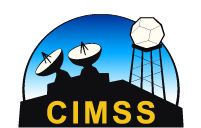
Video • iPad Video
SOS Playlists
 SOS Playlist
SOS Playlist
 SOS AutoRun/Audio Playlist
SOS AutoRun/Audio Playlist
Overview
Each month, we will provide information regarding the previous month’s climate. Overall, preliminary data analysis suggests that February 2013 was the 9th warmest on record (since 1880), tied with 2003. Major stories include a Nor’easter, warmer than normal summer for Australia, and above average snow cover for Eurasia and North America.
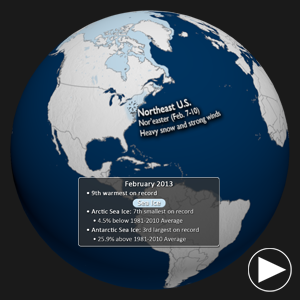
Highlights Preview • iPad Video
Highlights Dataset
Dataset: 20130325 EarthNow: February 2013 Highlights
Dataset: 20130325 EarthNow: AUDIO February 2013 Highlights
 Full Map Image
Full Map Image
- This dataset shows some of the major February weather and climate highlights from the National Climatic Data Center’s (NCDC) monthly global climate analysis, and serves as an overview of what can be discussed in the datasets that follow. Highlights are noted below with more information.
- Northeast United States: A Nor’easter brought heavy snow, strong winds, and coastal flooding to the northeastern part of the U.S. (Feb. 7-10)
- Australia: Australia experienced its warmest summer (Dec.-Feb.) on record. The average maximum summer temperature was 1.44˚C above the 1961-1990 average.
- Tropical Cyclone Haruna: With maximum winds of 150 km/hr, Haruna made landfall in southern Madagascar, impacting nearly 10,000 people and killing over 20. The storm brought very heavy rain and resulted in flash floods. (Feb. 28-25)
- Pakistan: Northern Pakistan experienced heavy rain in just a few days. In fact, some areas received the average February rainfall in just three days.
- Arctic Sea Ice Extent: Seventh smallest on record, at 4.5% below the 1981-2010 average.
- Antarctic Sea Ice Extent: Third largest on record, at 25.9% above the 1981-2010 average.
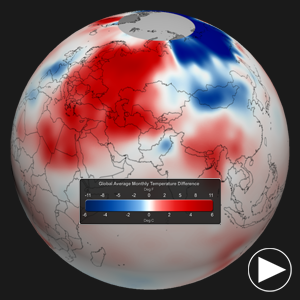
Temperature Preview • iPad Video
Global Temperature Anomalies Dataset
Dataset: 20130325 EarthNow: February 2013 Temperature Anomaly
Dataset: 20130325 EarthNow: AUDIO February 2013 Temperature Anomaly
 Full Map Image
Full Map Image
- Using the real-time Monthly Temperature Anomalies dataset is a great way to convey where some of the warmer and cooler than average areas were in February, including those mentioned above in the highlights.
- The combined global land and ocean average surface temperature for February was the 9th warmest on record (since 1880), tied with 2003.
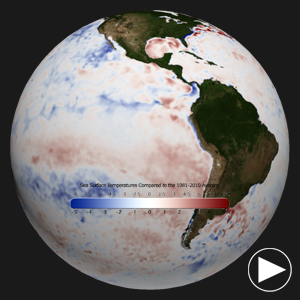
SST Preview • iPad Video
Sea Surface Temperature Anomalies Dataset
Dataset: 20130325 EarthNow: February 2013 SST Anomaly
Dataset: 20130325 EarthNow: AUDIO February 2013 SST Anomaly
 Full Map Image
Full Map Image
- The real-time sea surface temperature anomaly dataset is a great way to visualize the El Niño – Southern Oscillation (ENSO) cycle in the eastern tropical Pacific ocean. For February 2013, these waters were just slightly below average, indicating an ENSO Neutral period.
- Remember that the blues indicate cooler than average temperatures and reds indicate warmer than average temperatures (white: average).
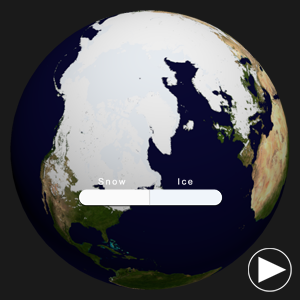
Snow and Ice Preview • iPad Video
Snow and Ice Cover Dataset
Dataset: 20130325 EarthNow: February 2013 Snow and Ice Cover
Dataset: 20130325 EarthNow: AUDIO February 2013 Snow and Ice Cover
 Full Map Image
Full Map Image
- Aside from helping to illustrate seasonal changes, the real-time Snow and Ice Cover dataset is a great way to convey sea ice change through time, including discussing how the current sea ice extent compares to other noteworthy years.
- The Arctic sea ice extent in February was the seventh smallest on record. The extent was 4.5% below the 1981-2010 average.
- In Antarctica, the sea ice extent was the third largest on record, at 25.9% above the 1981-2010 average.
- At 543,000 square kilometers above average, the North American snow cover extent was the 14th largest on record (since 1967).
- The Eurasian snow cover extent was the 18th largest on record (since 1967), at 776,000 square kilometers above average.
Where do I find the datasets?
-
First, check your SOS system to make sure it’s not already in the EarthNow category.
-
If not, you can download the datasets and playlist files from this FTP Site.
-
Then download and use playlist files at the top of the page (or create your own) and make sure they are in /home/sos/sosrc or /home/sosdemo/sosrc.
- More detailed information here
Helpful Resources for More Information
-
http://www.ncdc.noaa.gov/oa/ncdc.html National Climatic Data Center (NCDC)
-
http://www.ncdc.noaa.gov/teleconnections/enso/enso-tech.php About ENSO (El Niño/La Niña)
-
http://www.ncdc.noaa.gov/sotc/global/ NCDC’s Global Climate Report





